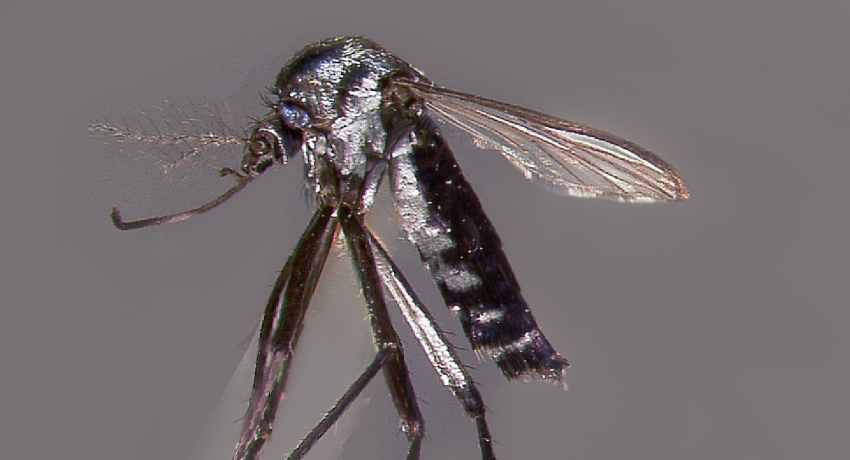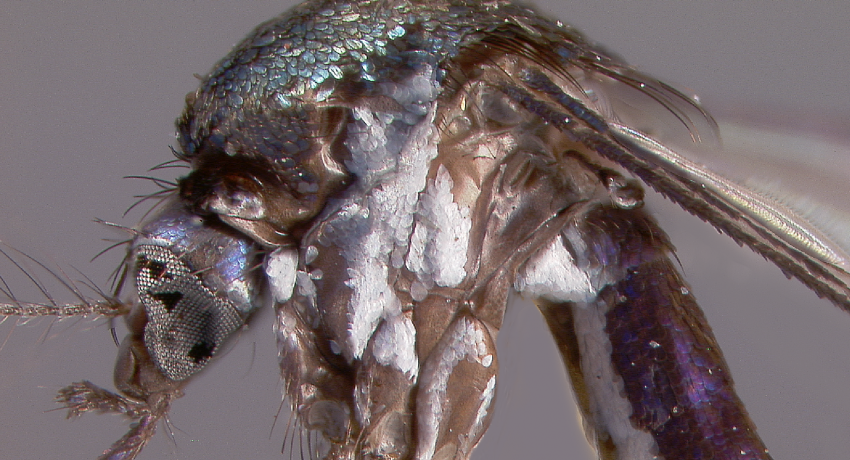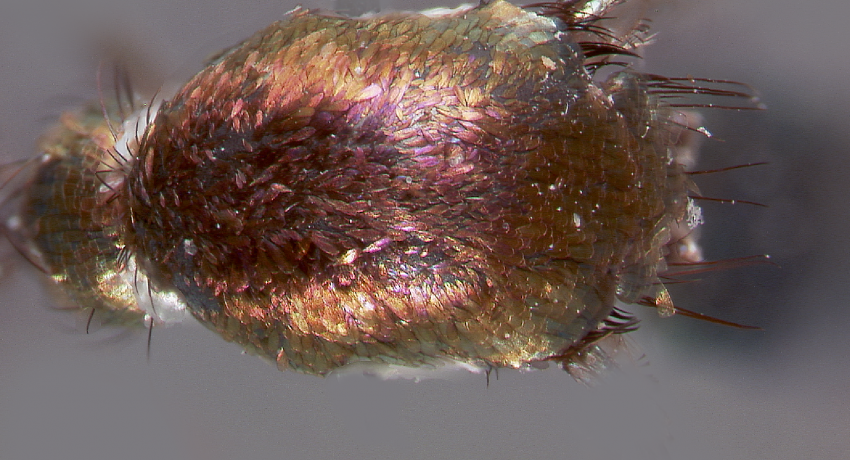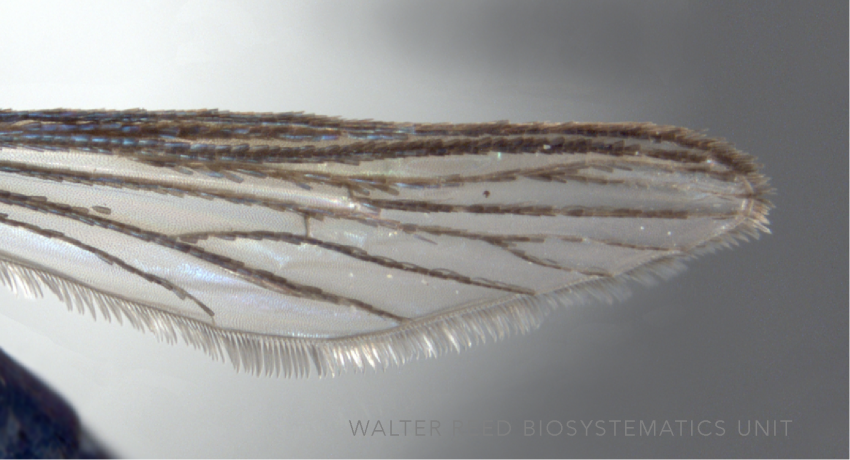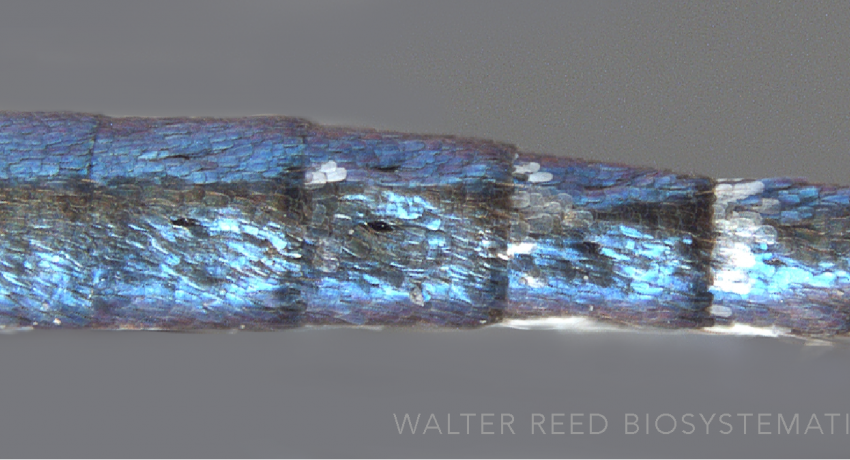NEOTROPICAL REGION
Generic abbreviation: Hg.
Type species: Haemagogus splendens Williston
Etymology: n.s. [haemo – blood & feeder? (Gr)]
The Aedine genus Haemagogus comprises 28 species, subdivided into two subgenera: Conopostegus (4 species) and Haemagogus (24 species). Uniquely within the subfamily, the palps of Hg. equinus Theobald are as long as the proboscis—a trait only otherwise found in Anopheline mosquitoes. Haemagogus (Haemagogus) mosquitoes are found in the southern United States, Central and South America. Conopostegus species occur from Honduras down as far south as northern Argentina and southern Brazil.
DIAGNOSTIC CHARACTERS (Click photos to view; mouse over and click large photo to zoom in.)
ADULT (illustrated): Head, thorax and abdomen covered with broad, distinct, reflective metallic scales. Thorax: Antepronotum large, closely approximated dorsally; prespiracular setae absent; C-III larger than C-II, dorsal margin of C-III slightly below or level with upper border of mesomeron; acrostichal, dorsocentral, and prescutellar setae mostly absent; pleuron with a broad vertical band of silver scales or with three arcs of silver scaled bands. Wing: Entirely dark.
LARVA (not illustrated): Head: Pale brownish head with darker collar. Thorax: Setae 5–7-P on very small isolated tubercles. Abdomen: Seta 12-I present and/or seta 7-III–V distinctly longer than corresponding seta 9-III–V. Terminal segments: Seta 3-VII well-developed and usually single; seta 5-VIII inserted well below dorsal margin of segment X; seta 4-X made up of five or six pairs of setae; saddle extends around half of segment X; single pair of seta 1-S inserted beyond pecten; comb with comb scales and pecten present.
TAXONOMIC KEYS
Lane 1953 (Neotropics)
Cova-García et al. 1966 (Venezuela)
Clark-Gil & Darsie 1983 (Guatemala)
Darsie 1985 (Argentina)
Liria & Navarro 2009 (Venezuela)
Marcondes & Alencar 2010
![]()
WRBU – Genera – Global – Larva
![]()
WRBU – Genera – Nearctic – Adult
![]()
WRBU – Genera – Nearctic – Larva
![]()
WRBU – Genera – Neotropical – Adult
![]()
WRBU – Genera – Neotropical – Larva
Exemplar DNA sequences
Hg. janthinomys COI: KY859893–96, KM593034–35
Hg. lucifer COI: KT766493–517
Hg. leucocelaenus COI: KX758543, MG242532
Hg. equinus COI: JX260698
BIONOMICS
Immatures
Haemagogus immatures are most commonly found in natural plant container habitats including tree holes, bamboo, and bromeliad axils. Eggs can survive desiccation for several months, until the habitats are inundated. Occasionally immatures have been reported in rock holes, ground pools and artificial containers.
Adults
Haemagogus species are closely associated with dense primary and gallery Neotropical forest habitats and coastal mangroves. Some species still exist in remnant forest patches in cities in the Neotropics. Female Haemagogus bite during the day, and hosts include birds, primates, and forest-dwelling mammals. Many Haemagogus species will also attack man at ground level, particularly in forest edges, clearings, and in mangroves. Other species (e.g., Hg. leucocelaenus Dyar & Shannon) spend almost their entire life cycle high in the canopy and only rarely descending to ground level. Due to long life spans and wildlife-man feeding cycles, many Haemagogus are important yellow fever virus vectors, including Hg. (Con.) leucocelaenus, Hg. (Hag.) capricornii Lutz, Hg. (Hag.) equinus, Hg. (Hag.) janthinomys, and Hg. (Hag.) lucifer (Howard, Dyar & Knab), Hg. (Hag.) mesodentatus (Komp & Kumm), and Hg. (Hag.) spegazzinii Brèthes).
*Associated pathogens: This list reports bacteria, viruses, and parasites recovered from, or experimentally passed through this species, and does not imply field vector status.
IMPORTANT REFERENCES (full citations below)
Williston 1896: 271 (as genus)
Lutz in Bourrell 1904 (subfamily Haemagoginae)
Lane 1953: 775 (taxonomy, bionomics, keys)
Martínez et al. 1961 (taxonomy; Argentina)
Forattini 1965 (review, taxonomy, bionomics)
Cova-García et al. 1966: 366 (key, taxonomy; Venezuela)
Belkin et al. 1970 (taxonomy, bionomics; Jamaica)
Arnell 1973 (revision)
Clark-Gil & Darsie 1983 (keys, bionomics; Guatemala)
Darsie 1985 (F, L; keys; Argentina)
Mitchell & Darsie 1985 (review, bibliography, distribution; Argentina)
Reinert 2002c (F genitalia*)
Reinert et al. 2004 (phylogeny, classification)
Liria & Navarro 2009 (key, bionomics, distribution; Venezuela)
Reinert et al. 2009 (phylogeny)
Marcondes & Alencar 2010 (key, distribution)
Wilkerson et al. 2015 (phylogeny)
Maestre-Serrano et al. 2013 (distribution)
Wilkerson et al. 2015 (phylogeny, classfication)
Soghigian et al. 2017 (molecular phylogeny)
VALID SUBGENERA
Conopostegus Dyar [Con.]
Haemagogus Williston [Hag.]
CURRENT GENERIC & SUBGENERIC SYNONYMS
Haemagogus
syn. Stegoconops Lutz 1905: 83 (as genus). Type species: Stegoconops capricornii Lutz. Important References: Howard et al. 1917: 863 (synonomy with Haemagogus); Dyar 1921g: 102 (from synonomy to subgenus Haemagogus); Arnell 1973: 20 (synonomy with Haemagogus).
syn. Cacomyia Coquillett 1906d: 16, 25. Type species: Haemagogus albomaculatus Theobald. Important references: Coquillett 1910: 516 (designation of type species); Howard et al. 1917: 863 (syn. with Haemagogus).
syn. Longipalpifer Leví-Castillo 1951: 10 (as subgenus of genus Haemagogus) [pp. 7-11 as Masculongipalpi but changed to Longipalpifer in accompanying Errata p. 10]. Type species: Haemagogus panarchys Dyar. Important reference: Arnell 1973: 20 (syn.).
CITED REFERENCES
Arnell, J. H. (1973). Mosquito studies (Diptera, Culicidae). XXXII. A revision of the genus Haemagogus. Contributions of the American Entomological Institute, 10(2), 1–174.
Belkin, J.N., Heinemann, S.J., & Page, W.A. (1970). The Culicidae of Jamaica (Mosquito studies. XXI) Contributions of the American Entomological Institute, 6(1), 458.
Clark-Gil, S., & Darsie, Jnr., R.F. (1983). The mosquitoes of Guatemala: their identification, distribution and bionomics, with keys to adult females and larvae, in English and Spanish. Mosquito Systematics, 15(3), 151–284.
Coquillett, D.W. (1906d). A classification of the mosquitoes of North and Middle America (Vol. 11). Washington, DC: Kessinger Publishing, LLC.
Coquillett, D.W. (1910). The type-species of the North American genera of Diptera. Proceedings of the United States National Museum, 37, 499–647.
Cova García, P., Oramas, E.S., & Rausseo, J.A. (1966). Mosquitos (Culicinos) de Venezuela. II. Ministerio de Sanidad y Asistencia Social, Caracas, II, 1–413.
Cova García, P., Sutil Oramas, E., & Rausseo, J.A. (1966). Mosquitos (Culicinos) de Venezuela. I. Ministerio de Sanidad y Asistencia Social, Caracas, 410pp.
Darsie, R.F., Jr. (1985). Mosquitoes of Argentina. Part I. Keys for identification of adult females and fourth stage larvae in English and Spanish (Diptera, Culicidae). Mosquito Systematics, 17(3), 153-23–253.
Dyar, H.G. (1921g). The genus Haemagogus Williston (Diptera, Culicidae). Insecutor Inscitiae Menstruus, 9, 101–114.
Forattini, O.P. (1965). Entomología Médica. 3.0 Volume. Culicini: Haemagogus, Mansonia, Culiseta, Sabethini, Toxorhynchitini. Arboviruses. Filariose bancroftiana. São Paulo: Universidade de São Paulo.
Howard, L.O., Dyar, H.G., & Knab, F. (1917). The mosquitoes of North and Central America and the West Indies. Systematic description. Part II. Carnegie Institute of Washington.
Lane, J. (1953). Neotropical Culicidae (Vols. I, II). São Paulo: University of São Paulo.
Leví-Castillo, R. (1951a). Los mosquitos del genero Haemagogus, Williston, 1896 en America del Sur. Ecuador, 77.
Liria, J., & Navarro, J.-C. (2009). Clave fotografica para hembras de Haemagogus Williston 1896 (Diptera: Culicidae) de Venezuela, con nuevo registro para el pais. Boletín de Malariologia y Salud Ambiental, 49(2), 283–292.
Lutz, A. (1905). Novas espécies de mosquitos do Brasil. Imprensa Médica, São Paulo, 3, 1-350.
Maestre-Serrano, R., Cochero, S., Bello, B., & Ferro, C. (2013). Registry and distribution update of the species of the Haemagogus (Diptera: Culicidae) genus in the Caribbean region of Colombia. Biomédica, 33, 185–189.
Marcondes, C.B., & Alencar, J. (2010). Revisão de mosquitos Haemagogus Williston (Diptera: Culicidae) do Brasil. Revista Biomédica (Rev Biomed), 21, 221–238.
Martinez, A., Carcavallo, R.U., & Prosen, A.F. (1961a). El genero Haemagogus Williston, 1896, en la Argentina (Diptera, Culicidae). Anales del Instituto de Medicina Regional Resistencia, 5(2), 63–86.
Mitchell, C.J., & Darsie, R.F., Jr. (1985). Mosquitoes of Argentina Part II. Geographic distribution and bibliography (Diptera, Culicidae). Mosquito Systematics, 17, 279–360.
Reinert, J.F. (2002c). Comparative anatomy of the female genitalia of genera and subgenera in tribe Aedini (Diptera: Culicidae). Part XI. Genus Haemagogus Williston. Contributions of the American Entomological Institute, 32(5), 17–30.
Reinert, J.F., Harbach, R.E., & Kitching, I.J. (2004). Phylogeny and classification of Aedini (Diptera: Culicidae), based on morphological characters of all life stages. Zoological Journal of the Linnean Society, 142, 289–368.
Reinert, J.F., Harbach, R.E., & Kitching, I.J. (2009). Phylogeny and classification of tribe Aedini (Diptera: Culicidae). Zoological Journal of the Linnean Society, 157(4), 700–794.
Soghigian, J., Andreadis, T.G., & Livdahl, T.P. (2017). From ground pools to treeholes: convergent evolution of habitat and phenotype in Aedes mosquitoes. BMC Evolutionary Biology, 17, 262.
Wilkerson, R.C., Linton, Y.-M., Fonseca, D., Schultz, T., Price, D., & Strickman, D. (2015). Making mosquito taxonomy useful: A stable classification of tribe Aedini that balances utility with current knowledge of evolutionary relationships. PLoS ONE, 10(7), e0133602.
Williston, S.W. (1896). On the Diptera of St. Vincent (West Indies) (Dolichopodidae and Phoridae), by Prof. J. M. Aldrich. Transactions of the Royal Entomological Society of London, 44, 253–446.
CITE THIS PAGE
Walter Reed Biosystematics Unit (Year). Haemagogus genus page. Walter Reed Biosystematics Unit Website, http://wrbu.si.edu/vectorspecies/genera/haemagogus, accessed on [date (e.g. 03 February 2020) when you last viewed the site].

